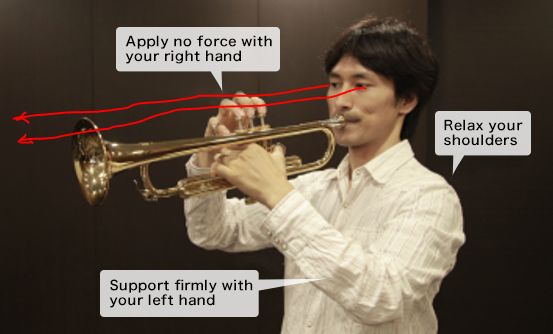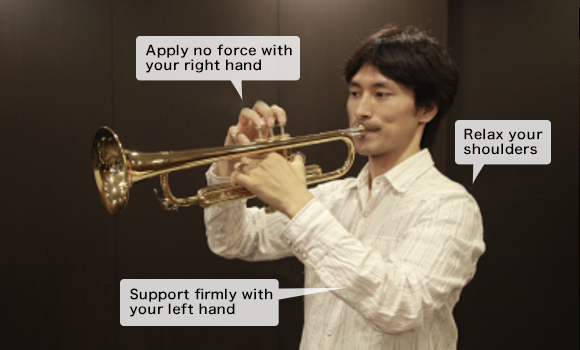Keying ~fingering
-
Over the decades i've listened to and observed great wind players who cover the holes with straight fingers using the side of the fingers. For example, Abdallah Helmy, the brilliant Egyptian kawala player. I started with the trumpet a couple months ago, and tried to imitate the textbook fingering approach with little finger in the hook, bent fingers, and tips on keytops. But I've gradually gone to straight fingers with sides on keytops. There is less strain involved. Am i at risk of excommunication for unorthodoxy?
-
I don’t think finger position on the valve buttons or in the pinky ring really matters, as long as it feels natural and doesn’t slow you down.
-
Curled fingers will place less side stress on the valves, reducing wear. Here's an example:
Bonus: Note posture, left hand placement, trumpet position, comments, and photo source.
-
@dale-proctor said in Keying ~fingering:
I don’t think finger position on the valve buttons or in the pinky ring really matters, as long as it feels natural and doesn’t slow you down.
Relieved to hear it.
-
Using flat fingers can mean uneven wear on your pistons and casings, which will eventually slow them down and cause you to need a rebuild. Nothing is worse than to try to play a trumpet with correct hand position that someone else has played with their knuckles for a long time - the only way the pistons will respond is if you play with your knuckles, too. If you value resale at all, try to keep your fingers curved and on the buttons.
-
LOOKING AT CUTE CHICK OUT IN THE AUDIENCE

-
Placement of the right thumb can make a big difference in how the fingers of the right hand can move up and down without torquing the valves. When I was first learning, I hooked my thumb under the lead pipe and around the first valve casing. It made for a secure grip for an eight year old but it was tough on valves. I learned as an adult that placing the thumb tip against the second valve casing provided support for the rest of the right hand and the pinky ring provided secure positions front to back along the lead pipe. This works for most of the time. I revert to the first valve thumb wrap temporarily when the left hand is needed for muting. Then I immediately go back to propping the thumb against the second valve case.
-
@curlydoc I was originally taught to place my right thumbnail against the first valve casing. It worked OK, except for some quick mute changes and especially when using a plunger mute. If there is a first valve trigger where the fulcrum is attached to the right side of the casing, as on Olds and Bach, for instance, this thumb placement will not work, as it conflicts with the lever/paddle.
My default position now is to rest my right thumb on the upper left first valve casing and rest my left thumb on the trigger button/paddle. On horns without a first valve trigger, my left thumb is in the first valve saddle/ring and wrapped around the first valve casing when there is no tuning aid there. This way I don't have to change a thing when using mutes. This may not work for people with fingers shorter than mine. The bottom line is that this enables me to comfortably press the valves down without side pressure.
FWIW - I avoid trumpets and cornets that have paddles where the fulcrum is placed in the middle of the valve casing. They're just too awkward for me. Oh, and mute changes are not an issue for the most part, since I usually change them with my right hand.
-
I've always rested pinky on top of the pinky hook and the thumb between the first and second valve casing. I tried resting on the first valve casing only but found that my fingers tended to wander a bit, so I am back with thumb between first and second valve. This still works best for me, so regardless of what the experts say, you have to use what works for you.
-
@georgeb said in Keying ~fingering:
... regardless of what the experts say, you have to use what works for you.Agreed. The goals are to play efficiently and comfortably and to not wear out the horn in the process.
-
@dr-go said in Keying ~fingering:
LOOKING AT CUTE CHICK OUT IN THE AUDIENCE

Clearly he is a droid, though.
-
@georgeb said in Keying ~fingering:
I've always rested pinky on top of the pinky hook and the thumb between the first and second valve casing. I tried resting on the first valve casing only but found that my fingers tended to wander a bit, so I am back with thumb between first and second valve. This still works best for me, so regardless of what the experts say, you have to use what works for you.
Your post made me conscious that I've been putting my thumb under the lead between the first and second valves, fingers flat over the valve keytops from there. This feels good and natural for now.
-
I personally change position of fingerings depending on the progression I am to play, and in some cases the horn I am using. As for both of my 4-valve flugelhorns, there is no finger hook on the bell as I did not want this to get in the way of the dexterity of using that fourth valve. Of interest, the Getzen came as a standard feature to NOT have a finger hook. The Kanstul had the finger hook standard, and I had to ask the Kanstul company to LEAVE THE HOOK OFF when I placed the order. They complied with the request and it has made me a very happy flugelhorn player.
As for my trumpets, I adjust finger position depending an the nuance I want to get out of a tune. Bebop gets the the "correct" details to keep the fingers rounded and directly over the buttons for the most rapid response and dexterity. However, for ballads I like to change the grip to place my dip joint over the keys as this allows me to slow and even when needed, half valve an attack of a note so as to get more "personality" out of a passage.
-
@dr-go Dip joint?
-
-
Not to be confused with the Juke Joint:


